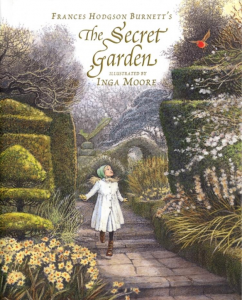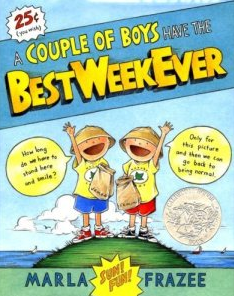Although “nature deficit disorder” may be the latest affliction to trouble today’s computer-glazed, keyboard-tapping kids, new research revealing the medicinal powers of a long day outdoors has literary roots that reach back a century.
For instance, “The Secret Garden” of Frances Hodgson Burnett’s turn-of-the-last-century classic has such a salutary effect on orphan Mary Lennox that her sallow complexion soon is replaced by roses in her cheeks. Her enfeebled cousin, Colin, finds the fabled Yorkshire air even more bracing, tossing off his lap blankets and rising up from his wheelchair, as straight and determined as a new crocus.
 That pivotal scene is one of the pleasures in an excellent reissue of the children’s classic, newly illustrated by Inga Moore (Candlewick, $21.99, 272 pages, ages 6 and up). Like many of the best illustrated books for children this spring, it reminds young readers, possibly as pasty-faced as Mary Lennox after the long winter, of the beautiful scenery, startling creatures and great adventures that await this season if we simply go outside. Consider:
That pivotal scene is one of the pleasures in an excellent reissue of the children’s classic, newly illustrated by Inga Moore (Candlewick, $21.99, 272 pages, ages 6 and up). Like many of the best illustrated books for children this spring, it reminds young readers, possibly as pasty-faced as Mary Lennox after the long winter, of the beautiful scenery, startling creatures and great adventures that await this season if we simply go outside. Consider:
“Jack Pine,” by Christopher Patton, illustrated by Cybele Young (Groundwood, 32 pages, $18.95, ages 7 to 12).
The Canadian poet picks up where Joyce Kilmer left off in this charming ode to the least lovely of trees — the jack pine. A tree once blamed by farmers for poisoning the soil may seem an unlikely subject for a children’s book, but Patton’s poem recasts Jack as an unsung hero of nature, taking root in the least hospitable places to protect the seedlings of more desirable pines from wind and sunlight.
“The Ugly Duckling,” retold by Stephen Mitchell, illustrated by Steve Johnson and Lou Fancher (Candlewick, $16.99, 40 pages, ages 5 to 8).
Inner beauty is another familiar theme in this satisfying retelling of Hans Christian Andersen’s classic. This odd duck’s diaspora from the nest forces him into frightening face-to-face encounters with everything from prowling hunting dogs to prejudiced house cats. Fortunately, the illustrators’ inventive relief of fine lace against the bird’s fuzzy feathers hints at the elegant makeover that awaits the creature if only he can hang on until spring.
“Big Yellow Sunflower” and “Little Green Frogs,” by Frances Barry (Candlewick, $5.99, 22 pages, ages 4 to 8).
Equally magical metamorphoses fill the pages of these “fold out and find out” books. The first follows a sunflower seed as it takes root, the pages revealing the flower’s giant petals; the second follows as frog eggs become tadpoles, then miraculously lose their tails and morph into frogs.
“Arabella Miller’s Tiny Caterpillar,” by Clare Jarrett (Candlewick, $16.99, 32 pages, ages 5 to 7), similarly plots the relationship twists and turns of a little girl and the caterpillar she finds on her sleeve. While the rhyming verse and color-splashed pages are appealing to small children, more nourishing nature information can be found on the book’s final spread, which explains the life cycle of the butterfly, from egg to pupa and beyond.
“When Rain Falls,” by Melissa Stewart, illustrated by Constance Bergum (Peachtree, $16.95, 32 pages, ages 4 to 8), and “Wetlands,” by Cathryn Sill, illustrated by John Sill (Peachtree, 48 pages, $16.95, ages 2 to 6).
Here are two educational options for young nature lovers who prefer a nonfiction approach. The first explains where animals go when the weather turns bad. The second, one in the authors’ About Habitats series, explains how wetlands go to work after a good soaking, protecting us from floods, slowing storm waves on the ocean and helping to keep the Earth’s water clean. Although the simple writing is intended as an introduction to the topic, the gorgeous watercolor illustrations will entertain the adults expected to turn the pages.
“Wild Tracks! A Guide to Nature’s Footprints,” by Jim Arnosky (Sterling, $14.95, 32 pages, ages 4 to 8).
Was that muddy paw print left by the dog next door, or something much wilder? The answer may be found in this informative book, which offers life-size fold-out illustrations of the foot (and hoof) prints left behind by everything from deer and timberwolves to pronghorn antelope and white ibises. The accompanying text explains how animal tracks may look different — or even deceive — depending on the conditions. For instance, on slippery surfaces, a bear’s toes will spread apart for better stability, leaving footprints that may appear much larger than the animal actually is — useful and even reassuring information for your family’s backwoods hiking trip this summer.
 “A Couple of Boys Have the Best Week Ever,” by Marla Frazee (Harcourt, $16, 40 pages, ages 4 to 8).
“A Couple of Boys Have the Best Week Ever,” by Marla Frazee (Harcourt, $16, 40 pages, ages 4 to 8).
Of course, it’s important for parents to remember that while you can lead a kid to the woods, you can’t make him like it. Based on “real people and real events,” this goofy, hilarious and warmhearted story follows the adventures of James and Eamon, two boys who bond one week at Eamon’s grandparents’ beach house over their mutual disdain for nature camp. (“I think it should be called Sit-Around Camp,” says one. “Yeah, or Sweat-a-Lot Camp,” says the other.) Although Grandpa Bill tries to interest the boys in penguins, and Grandma Pam plies them with pancakes, the boys prefer to watch TV — that is, until their last night on the beach, when they finally venture to the shoreline and find out firsthand why researchers believe that time outdoors helps improve kids’ focus, sense of cooperation and collaboration. (By the way, this book contains the most authentic depiction of a blow-up, guest-room air mattress ever seen in children’s literature.)
“There’s Nothing to Do on Mars,” by Chris Gall (Little, Brown, $16.99, ages 3 to 6).
Planet Earth may not be the only place where kids need a little nudge to explore. In this galactic romp, Davey Martin and his robot dog, Polaris, are forced to find what fun they can on the Red Planet, building forts out of gravity-defying Mars rocks and spying on Martians, most in desperate need of a shower after so many eons on a waterless planet. Boredom solves that problem when Davey’s aimless dig on a crater springs such a gusher that the Martian shoreline suddenly resembles Florida, prompting Davey’s pioneer parents to set off for another, less populated planet. One fully expects a sequel someday, “There’s Nothing to Do on Saturn.”
Laura Billings is a health columnist for Mpls.St.Paul magazine.
This article appeared in the Minneapolis Star Tribune, April 28, 2008
